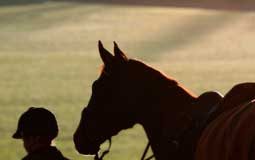While many people know horses can be used for therapy, they often don’t understand that there are several different kinds of therapy. And while many people have heard of therapeutic riding centers, far fewer have heard of equine assisted psychotherapy.

What is EAP?
Equine assisted psychotherapy (EAP) is a kind of experiential learning that allows individuals to reflect, learn and/or observe through interactions with horses.
EAP can be used for a variety of goals, including, but not limited to, helping those who suffer from anorexia and bulimia, providing exercises for team building, and offering a unique environment to individuals who want something different than therapy in a clinic environment.
EAP Logistics
- Safety is always a top priority.
- For the safety of all involved, EAP sessions are usually conducted with at least two professionals, a horse professional and a mental health professional.
- Many EAP exercises are most effective when participants are able to think metaphorically in order to make connections between what happens in the arena with the horse(s) and what happens in every day life.
- No horse knowledge is required from the participant(s) in EAP.
- EAP, like many other types of therapy, can be done with an individual or a group.
- As with any form of therapy, the objectives and paths of sessions are catered to the specific individual(s).
An Example Introductory EAP Exercise
A simple and often introductory EAP exercise is to ask an individual to catch and halter a horse. The point of the exercise is not about horsemanship skill; there isn’t a wrong way to put the halter on the horse.
Time limits may not be set. Directions can be as simple as, “Catch and halter the horse. Then lead the horse to the side of the arena where we started the exercise.”
A key element of an EAP exercise is to reflect on the experience. Once the individual completes the task, the mental health professional can ask questions and allow the individual to reflect. For example, the professional could ask, “I noticed you laughed when the horse walked away from you when you almost had a chance to put the lead rope around his neck. In life, do you ever laugh when someone turns away?”
The individual is then given a chance to reflect on and answer the posed question. Another example of a question from the professional could be, “How did you feel when you put the halter on the horse?”
The individual would then have a chance to share how he or she felt after successfully completing a task. At that point, the mental health professional could bring the conversation back to the individual’s life outside of the EAP session and ask, “How was this experience similar or different to when you accomplish a task in your regular life?”
Team Building Exercises
At some point in your life, you may have participated in a ropes course or something similar. Ropes courses typically involve personal development or team building tasks using outdoor obstacles. EAP group exercises can be used for similar purposes.
An example of a group exercise is to work with one horse, a flake of hay, and a hula-hoop. In this example, the flake of hay would be placed on the opposite side of the arena from the hula-hoop.
The group’s assigned task would be to get the horse to place one foot in the hula-hoop when it is flat on the ground, and the rules of the exercise would include not being able to touch the horse and not being able to move the hay.
While the exercise might sound impossible considering most horses will have high interest in the food and low interest in the hula-hoop, the way the task is successfully completed or even unfinished will provide several questions for the mental health professional to direct toward the group for reflection.
Get Involved with EAP
If you’re interested in learning more about EAP, whether for participation or for professional involvement, seek out an EAP professional in your area. Some facilities specialize in EAP, and others offer one or more specialized EAP professionals.
Contact a local facility that offers any form of equine-related therapy and inquire about sources for EAP, or contact the Equine Assisted Growth and Learning Association (www.eagala.org).
Liked this article? Here are others you’ll love:
Criteria for Therapy Horses
Grant Will Fund Research into Equine-Assisted Therapy for Veterans






What every horse owner already knows about horses being psychotherapy.
I get my psychotherapy several times a day. Must be why I’m so well adjusted. 🙂
I am a PATH International Certified Equine Assistant I am qualified to work in this field and am open for clients.